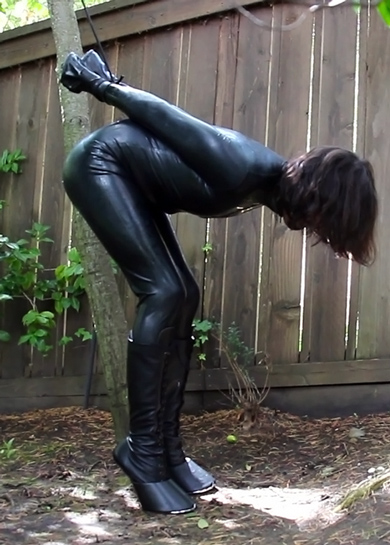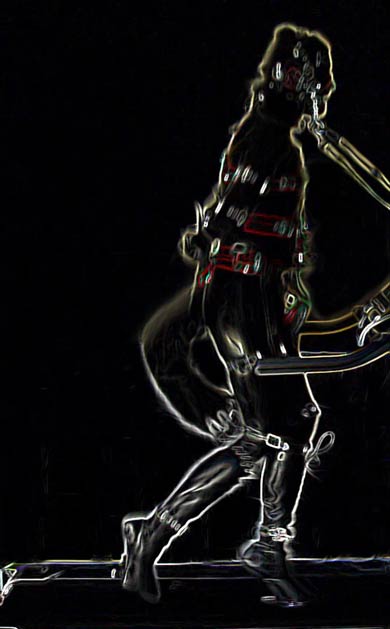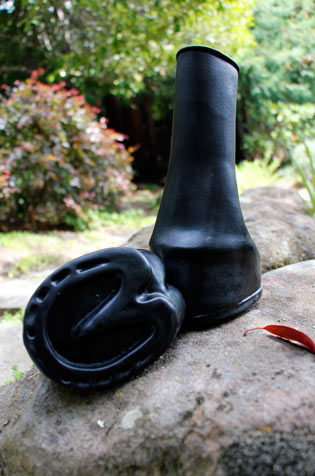
There's nothing like a little strappado on uneven ground to break your pony into his hooves (short hoof boot strappado video).

There's nothing like a little strappado on uneven ground to break your pony into his hooves (short hoof boot strappado video).
Training a human pony is often more difficult than training a bio-horse. Sure, there's the advantage that a human pony can understand your verbal commands without any training, but that comes with the disadvantage of him being able to make those same human sounds, which means you now need to teach him that horses don't talk.
What makes human pony training particularly challenging is that in addition to training your human pony to pull a cart, be ridden, etc., you also have to teach him to be a pony. Aside from decking your pony out to look the part, he also needs to learn what sounds to make (and equally important: when to make them), and what body language to use, and even how to swish his tail.
Thus, before you can break your pony to the bit and bridle, you first have to both familiarize him with the pieces of equipment that make him appear more equine and also train him to act more equine.
I want to cover a few of these "pre-training" topics in a series of installments. Today, I would like to cover hooves (my favorite piece of non-tack equipment). The biological animal has a good handle on these from birth, but most humans are not intrisically adept at walking on their toes, nor is prehensility easily transferred from fingers to lips. These things have to be taught to human ponies.
Thus, training methods and exercises unique to the human pony have to be developed. Ideally, the methods we devise will require minimal effort for the trainer since at this stage we are merely getting the pony used to the idea that he is a pony. Thus it is not an optimal use of a trainer's time. We can also tailor the exercises to a potential pony's tastes.

Treadmill time in hoof boots builds stamina and improves the pony's balance.
For example, I love bondage, so a good way to further my training in hoof boots is to use bondage to force me to keep my balance in them. In the photo at the top right, I am wearing hoof boots and have my arms pulled up behind me in a mild strappado position. The nature of this position requires me to pay very close attention to balance and required only minimal supervision by my trainer.
The position can become uncomfortable for any real length of time, but it's a great way to occupy your pony (he'll be far too busy trying to maintain his balance to concentrate on aything else. I would lift one hoof only slightly to take the weight off that toe momentarily, and it would set me off balance and leave me shifting and stumbling as much as I was able to regain my footing) for short periods of time and give him a crash course in balancing in hoof boots. If you do try something like that, be very careful (you don't want any dislocated arms from ponies losing their balance)!
If your pony is not ready for much bondage, you could simply tie his reins or lead rope to a hitching post (or other fixed object) such that he must remain standing in his hooves. Alternatively, a little time on the treadmill in hoof boots will both exercise your pony and help him improve his balance. Indeed, I personally find that walking around in hooves is actually easier than just standing in them. You can of course hand walk your pony while he's wearing his hooves if you don't own a treadmill or want a more hands on approach to training him.
The goal of these various exercises, is to get your pony comfortable in his hoof boots so that ultimately he can move through all the gaits flawlessly while wearing them. At some point, walking on his toes in the boots will become natural, and they will cease to be an element of bondage and simply be his feet.
Getting your pony used to his fore hooves (i.e. hoof gloves) is a little easier. He does not need his fingers for balance, and forcing his hand into a fist in the mitts will not cause much discomfort except when done for very long periods of time (e.g. several days) or if the glove is overly tight.

Similarly, human ponies need to become comfortable without the use of their fingers. Wearing hoof gloves for most scenes, or even when lounging around, can help.
At first it will be disconerting for your pony not have the use of his fingers. A human pony will often feel quite helpless without the use of his fingers, which is to be expected. To help remdy this, I often recommend a two pronged approach to breaking a pony into his fore hooves (FYI: vetwrap, or standard fist mitts can easily be substituted for the rubber hoof gloves). The first step is getting him used to the restriction of the gloves. This is pretty easy: just have him wear them for blocks of time (e.g. while relaxing), and eventually overnight.
The second step involves teaching your pony to transfer some of the functions of his fingers to my lips (for those who aren't aware, horses use their lips in the same way that humans use their fingers, even going so far as to unsnap clasps and let themselves out of stalls or pens). A great way to do this is to tie your pony's reins to a post and have him practice untying it with his mouth (if he uses his teeth, put a thin bit in his mouth; the goal is for him to use his lips to untie it).
Similar to the hoof boot training exercises above, the goal is to make a pony comfortable to operating without fingers, with hooves instead of hands. This also means a pony should be permitted to use his hooves as a human would use his hands (i.e. he shouldn't be trying to adjust his bit (I'm often guilty of this) or his tack, etc.). The latter requires quite a bit of practice, but that's part of the fun.
Obviously not everyone has (or wants) hoof boots or gloves, but I wanted to illusrate my point that some items of equipment (like hooves) aren't really tack per se. These items are solely used to bring a human to where a horse is naturally (in this case anatomically). Thus for the ponies that are planning on wearing them, it's advisable to get your pony used to the equipment before attempting to train him in it.